Alaska Fishing: The Anchorage Management Area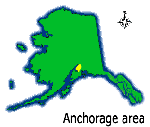
The Alaska Department of Fish and Game’s Anchorage Management Area dominates upper Cook Inlet, and includes all waters draining into the west side of Cook Inlet's Knik and Turnagain Arms, starting at the Eklutna (ee-kloot-na) River on the Knik (kinnick) Arm and ending at Ingram Creek, on the Kenai Peninsula. Many of the lakes are stocked by the Department each year, while some are stocked only occasionally, and a handful of lakes contain populations of indigenous fish species. Some of the rivers in the Anchorage Management Area are stocked with king salmon, and many have indigenous runs of silver or chum salmon. See each listing for details.
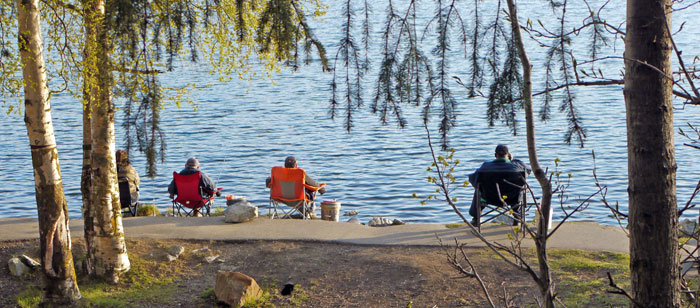
How This Section is Organized
Because the Anchorage Management Area offers diverse freshwater fishing opportunities, and because it serves as a base camp or "jump-off point" for fly-out or road-based freshwater and saltwater angling opportunities elsewhere, we’re breaking it down for you. This page focuses exclusively on freshwater fishing available directly in the Anchorage Management Area. Other pages in this section discuss how to access the numerous road-based and fly-out angling opportunities available if you base your trip in Anchorage.
Anchorage Management Area Basics | Fishing the Anchorage Bowl | Fishing North and South of Anchorage | Anchorage as a Base Camp
For information pertaining to specific species, including recommended gear and techniques to catch them, refer to our species pages, our fishing methods pages, and our fishing gear pages.
Species | Fishing Methods | Fishing Gear
About the Anchorage Management Area
The Alaska Department of Fish and Game’s Anchorage Management Area dominates upper Cook Inlet, and includes all waters draining into the west side of Cook Inlet's Knik and Turnagain Arms, starting at the Eklutna (ee-kloot-na) River on the Knik (kinnick) Arm and ending at Ingram Creek, on the Kenai Peninsula. Many of the lakes are stocked by the Department each year, while some are stocked only occasionally, and a handful of lakes contain populations of indigenous fish species. Some of the rivers in the Anchorage Management Area are stocked with king salmon, and many have indigenous runs of silver or chum salmon. See each listing for details.
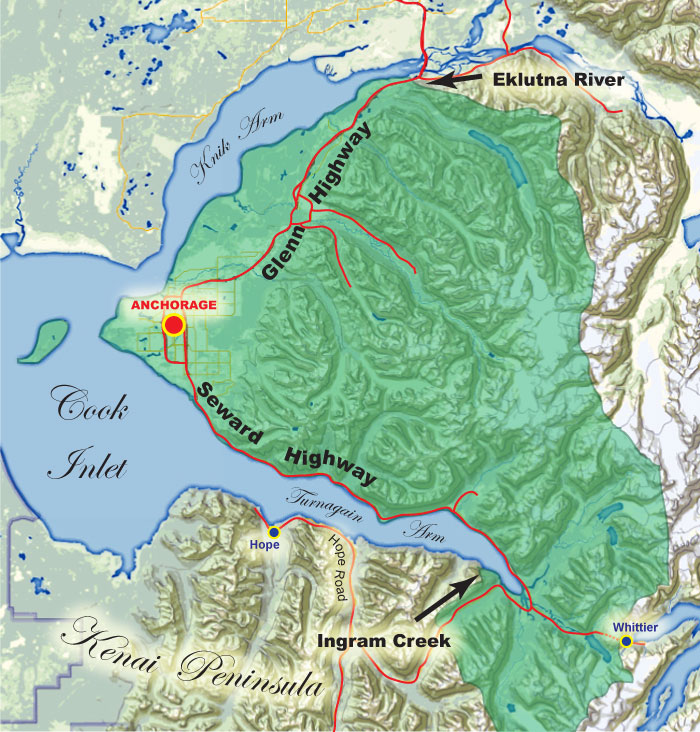
Map of the Anchorage Management Area
About Cook Inlet
Cook Inlet is named after James Cook, who explored the area in 1778, in search for the Northwest Passage. William Bligh, Cook's sailing master, is credited with naming the Turnagain Arm, following his efforts to explore the reaches of upper Cook Inlet. Bligh dispatched a team of men to sail up the Knik Arm, only to discover that the arm ended in a glacial river (the Knik River). Another team was dispatched to explore the remaining arm and was similarly turned back by mud flats where that arm also ended in tributary rivers. They had to "turn again" and the expedition continued back the way it came. The name stuck, and to this day the southern arm of Cook Inlet is known as the Turnagain Arm. Bligh made history eleven years later when his crew mutinied, setting him adrift in the ship's launch, while sailing away on the HMS Bounty.
Anchorage Run Timing Chart
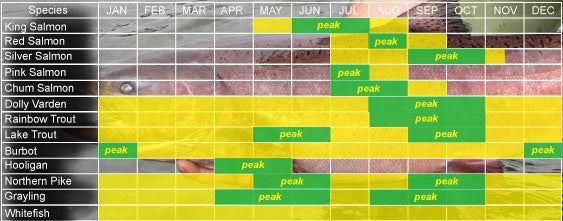
Peak freshwater fishing times for the Anchorage Management Area
Special Cautions for the Anchorage Management Area
Like any other place in Alaska, the Anchorage Management Area presents unique characteristics that anglers must be familiar with. Some of these things pertain to safety, while some pertain to the health of our fish and wildlife populations. This list is not exhaustive, but it gives you some general things you need to know about this area.
About Anchorage's Wildlife
The Anchorage Management Area contains healthy populations of black bears and brown / grizzly bears, which are distributed throughout the remote reaches of the Chugach Mountains, and down onto the rolling timbered hills of the Eagle River / Chugiak area, along the shores of both arms of Cook Inlet, and within the city limits of Anchorage itself. Though it is unlikely that you will encounter a bear in open areas of town where there are a lot of people, exceptions do occur. The chances of encountering a bear increase dramatically along salmon streams during late summer, especially in areas of dense vegetation. Bears work the area streams, fishing for spawning salmon. Use caution when fishing any stream that contains salmon. Some areas of particular concern in the Anchorage Management Area include upper Ship Creek, Campbell Creek, and Chester Creek.
Wolves live in the Chugach Mountains, and occasionally make their way inside Anchorage city limits on occasion. Though generally shy, wolves will on occasion stand their ground or even approach humans. Attacks are rare, but possible, and the chances of an unfavorable encounter may increase if you have a dog with you. Fatal encounters with humans have occurred.
Moose are found throughout the area, and have become accustomed to humans to the point of tolerance. Moose can become aggressive when agitated, and may charge a person, striking with their powerful front hooves. Human fatalities have occurred from moose attacks. Photographers should keep a distance of at least 50 yards. If you encounter a moose on a trail, back off. Of particular concern are cows with calves, and mature bulls during the September - October rutting period.
In all cases, maintain a safe distance from these animals. Learn proper defensive techniques to protect yourself, and consider carrying a firearm, where legal, for protection outside Anchorage city limits.
About Invasive Species
The term "invasive species" refers to any non-native plant or animal species that have a negative effect on the indigenous ecosystem. The Anchorage Management Area has several invasive species that have a very negative effect on our fishing opportunities. Here is a partial list.
Northern Pike
Although pike are indigenous to other parts of Alaska, their introduction into South-central Alaska waters has had a devastating effect on all indigenous and stocked populations of fish. Pike are voracious predators, devouring any and all fish smaller than themselves. When pike are initially introduced to a lake, they systematically wipe out local populations of salmon fry and smolts, trout, grayling and char, along with smaller pike. After several spawn cycles, and following the die-off of larger pike, the population begins to mature at a younger age / smaller size, and eventually the lake is infested with small "hammer handle" pike.
Blackfish
Blackfish are indigenous to some areas of Alaska, but have been dumped in some Anchorage lakes and creeks. Though they are not large in size, they have a voracious predatory instinct, consuming salmon smolts and smaller trout and char. Over time this results in drastically reduced production of other species, including salmon.
How Did Invasive Fish Get Here?
Fish can be moved from one drainage to another unintentionally. They can become trapped in the floats of a float plane and pumped out when the plane lands elsewhere, for example. Most commonly, however, are intentional transplants by anglers wanting to catch that species in another lake or stream. Anglers should note that such transplants are illegal and carry severe penalties. If you want to catch pike or blackfish, simply visit areas of Alaska where they are indigenous, rather than ruining a fishery where other species are already in balance.
Remedies for Invasive Species
Though there are several means of removing invasive fish species (netting, angling, draining the lake or stream, etc.), the proven method used in Alaska involves the use of rotenone. Rotenone is a naturally-occuring compound derived from the roots of certain plants grown in South America. It's been used for centuries by people trying to catch fish for food. It works by inhibiting the fish's ability to assimilate oxygen from the water. Very small quantities of rotenone are deposited in a lake or stream, and in short order, all the fish in that body of water are killed. The rotenone dissipates in a short amount of time, and the lake or stream is re-stocked. A lot of work goes in to deciding whether or not to rotenone a lake or stream, and includes many factors such as the impact on other species, the impact on anglers using the resource, the ability of biologists to remove the dead fish and other factors. For these reasons, rotenone is often applied in the fall months, before the lake freezes over. This allows the lake to recover, while any dead fish can decompose and become a food source for insect larva that live in the lake. Rotenone is not harmful to humans, and does not have a cumulative effect on other organisms. Mammals are immune to its effects. At this writing, several lakes in the Anchorage area have been treated with rotenone, and several others are being studied for treatment, in order to eradicate non-native northern pike and blackfish.
About Nesting Waterfowl
The Anchorage Management Area is a nesting area for many species of waterfowl, including ducks and geese, loons, grebes, and shorebirds. Use extra caution when fishing lakeshore areas that might contain nests, eggs, or hatchlings. Some species are very protective of their nesting areas and their young, and a close approach can result in an attack. Loons are particularly aggressive, as are Arctic Terns. Steer well clear of nesting areas.
About Cook Inlet's Mud
Both arms of Cook Inlet are fed by glacial rivers and streams. As a glacier moves down a valley, it grinds away at the surrounding rocks, grinding them to a find powder known as glacial flour. As the glacier melts, the resulting river carries this fine silt down to the ocean. The silt is so fine, that in some rivers in Alaska it remains in suspension in the water column and is carried hundreds of miles downstream. The silt in upper Cook Inlet has accumulated into huge tidal mud flats that blanket both sides of both the Turnagain and the Knik arms, including their associated river confluences. Because this silt is so fine, it's very easy for anglers to become mired in the mud, to the point that they cannot get out before the tide rises. Over the years several people have died as a result of becoming trapped in the mud and drowning when the tide came in. Cook Inlet has the second-highest tides in the world, with a difference between high and low tide of as much as 30 feet. An incoming tide can move as fast as eight or ten miles per hour, providing little or no time for escape.
Several precautions can be taken to prevent a tragedy on the mud flats. First, avoid the mud altogether. Second, never fish the Inlet alone. Having a friend along provides you with someone to call for help, and to help you extract yourself from the mud. Third, if you find yourself on the mud, keep moving toward drier ground in order to avoid sinking. Finally, if you do become trapped, immediately call for help. It's very difficult to self-rescue.
Elsewhere in this Section
We've broken the Anchorage Management Area into smaller pieces, so you can focus on your particular area of interest. Here's an overview:
Orientation to the Anchorage Management Area (this page)
This section deals with some of the basic information you need to know about this area; a brief history of the area, the layout of the area, safety concerns (including dealing with the local wildlife), and available services.
Fishing The Anchorage Bowl
This page deals with fishing opportunities in Anchorage itself, and JBER, the military base just north of town.
Fishing North and South of Town
There are a lot of places to fish on the road system north and south of Anchorage. This page lists them in detail, along with available species and amenities.
The Seward Highway South to Ingram Creek
Beginning at Potter Marsh, a popular wildlife viewing area on the south end of Anchorage, the Seward Highway extends southward along the Turnagain Arm of Cook Inlet, to Portage and on to the Kenai Peninsula. The highway forms a narrow border between the steep, rugged Chugach Mountains and the treacherous tidal flats of the Turnagain Arm. There are several good fishing areas in this zone, which are covered in our "Anchorage: Just out of Town" page.
The Parks Highway North to Eklutna
The George Parks Highway begins at the north end of Anchorage, and extends northward 350 miles to Fairbanks. But the Anchorage Management Area extends only to the Ekutna River, which is covered in our "Anchorage: Just out of Town" page. Check it out!
Anchorage as a Base Camp
Lots of people base their fishing adventures out of Anchorage, either driving or flying out to adventures in other parts of South-Central Alaska or beyond. This page will get you started!
Be Bear-Aware!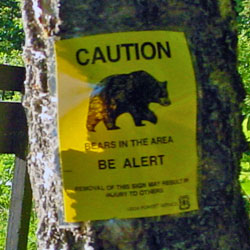
Alaska is bear country! Anglers must be aware of the possibility of encountering bears along any salmon stream. and some people are surprised to discover that brown bears are relatively common even in the heart of Anchorage. This is particularly true along any of the four salmon streams in Anchorage. The upper reaches of Ship Creek, and extending west of Reeve Blvd. can contain occasional bears, especially in brushy areas above the Ship Creek Dam. Chester Creek and Campbell Creek flow through the heart of Anchorage, and each is bordered for much of its length by a brushy greenbelt that provides cover for bears looking for salmon in mid to late summer. Rabbit Creek may also harbor bears, but this stream is choked with brush and not as commonly fished. Take the following precautions:
- Make plenty of noise while hiking or fishing.
- Don’t give bears a reason to associate people with food! Keep food and your catch in a backpack on your back.
- Protect yourself! Bring a pepper spray to use as a deterrent. The discharge of firearms within city limits is prohibited, though you are allowed to carry a firearm with you. Alaska's firearms laws are very liberal, though there are some places in town where you are prohibited from carrying a gun. Check the local regulations or contact the Anchorage Police Department for clarification. If you choose to use a firearm as a primary bear defense weapon in town, first consider the risks of discharging a weapon in circumstances where brush and vegetation may obscure the area near or behind the charging bear, creating a risk of injury to others in the area.
Area Sponsor
Classic Alaska Charters offers excellent overnight custom cruises aboard the “Saltery C”, their fully-outfitted 40’ live-aboard Bayliner Explorer Motoryacht. Each trip is an adventure customized to your requirements. Meals prepared by the onboard chef are unequalled in the business, and include healthy entrees such as fresh Alaska seafood and delicious desserts. Activities include fishing (freshwater and saltwater), kayaking, wildlife viewing, photography, crabbing & shrimping, hiking and just relaxing along the spectacular waterways of Ketchikan, Prince of Wales Island and Misty Fjords National Monument.
CAC is a US Coast Guard certified & registered guide / outfitter with the US Forest Service and ADF&G. Adcanced booking required… 6-12 months in advance, at least! Ketchikan Alaska fishing with Captain Rob is a true wilderness experience! We also have our Federal Halibut Permit for 6 anglers. Call or This email address is being protected from spambots. You need JavaScript enabled to view it. ! We’d love to have you aboard! 1 (907) 225-0608.
Need More Information?
Check out our other Anchorage Management Area fishing pages!
Anchorage Management Area Basics | Fishing the Anchorage Bowl | Fishing North and South of Anchorage | Anchorage as a Base Camp
If you’re looking for other areas to fish in Southcentral Alaska, check out our pages for the following areas:
Southcentral Fishing | MatSu Fishing | Southcentral Boat Launches
If you’re interested in hunting opportunities in Southcentral Alaska, check out our hunting pages at the following links:
Southcentral Hunting | MatSu Hunting
Rules and Regulations
The Alaska Department of Fish and Game is responsible for maintaining the sport fisheries across the state of Alaska. Their website provides a wealth of information about our sport fisheries as well as the regulations you need to know. Additionally, the Department issues Emergency Orders throughout the season, that have a direct bearing on last-minute changes in bag limits, openings and closings of seasons and much more. Fishermen are responsible for knowing the regulations, including these Emergency Orders. You can find all of that information and more at the Alaska Department of Fish and Game’s website, or at the regional office in the area where you are fishing.
ADF&G Sportfisheries DivisionAnchorage Office:Alaska Department of Fish and Game
333 Raspberry Road
Anchorage, AK 99518
1 (907) 267-2186
